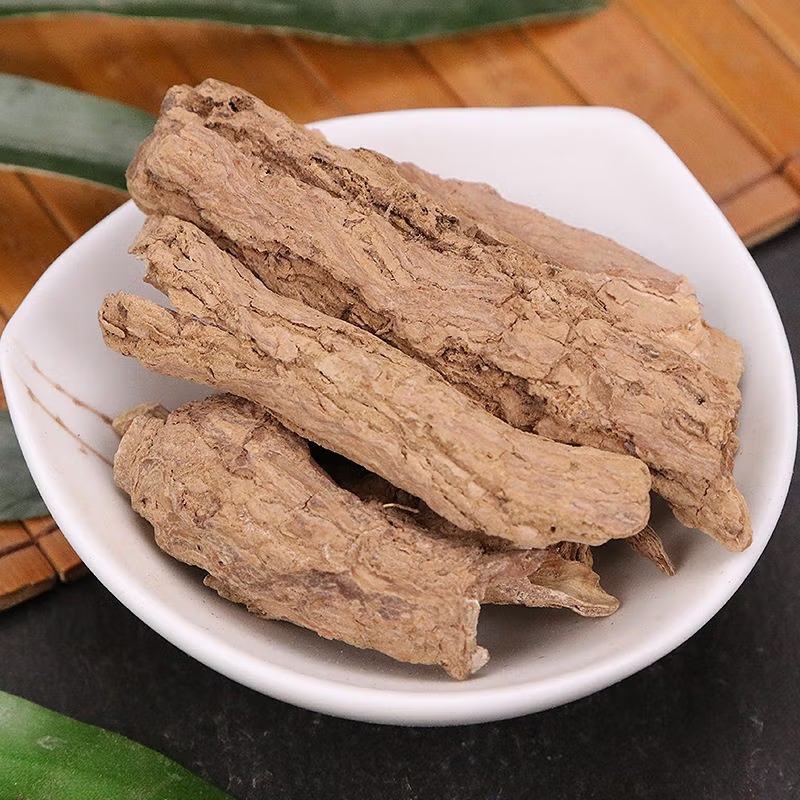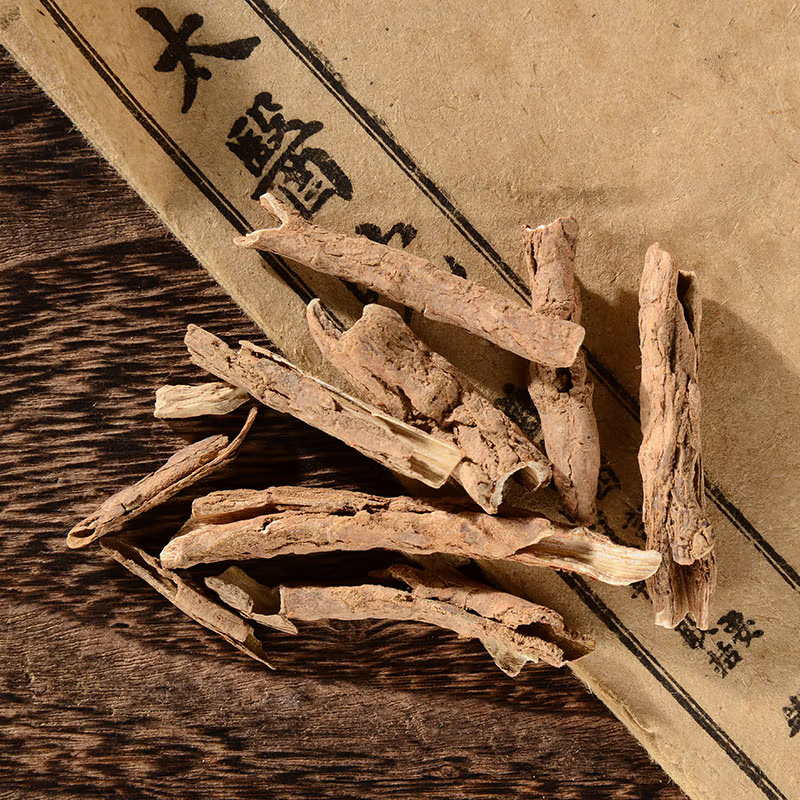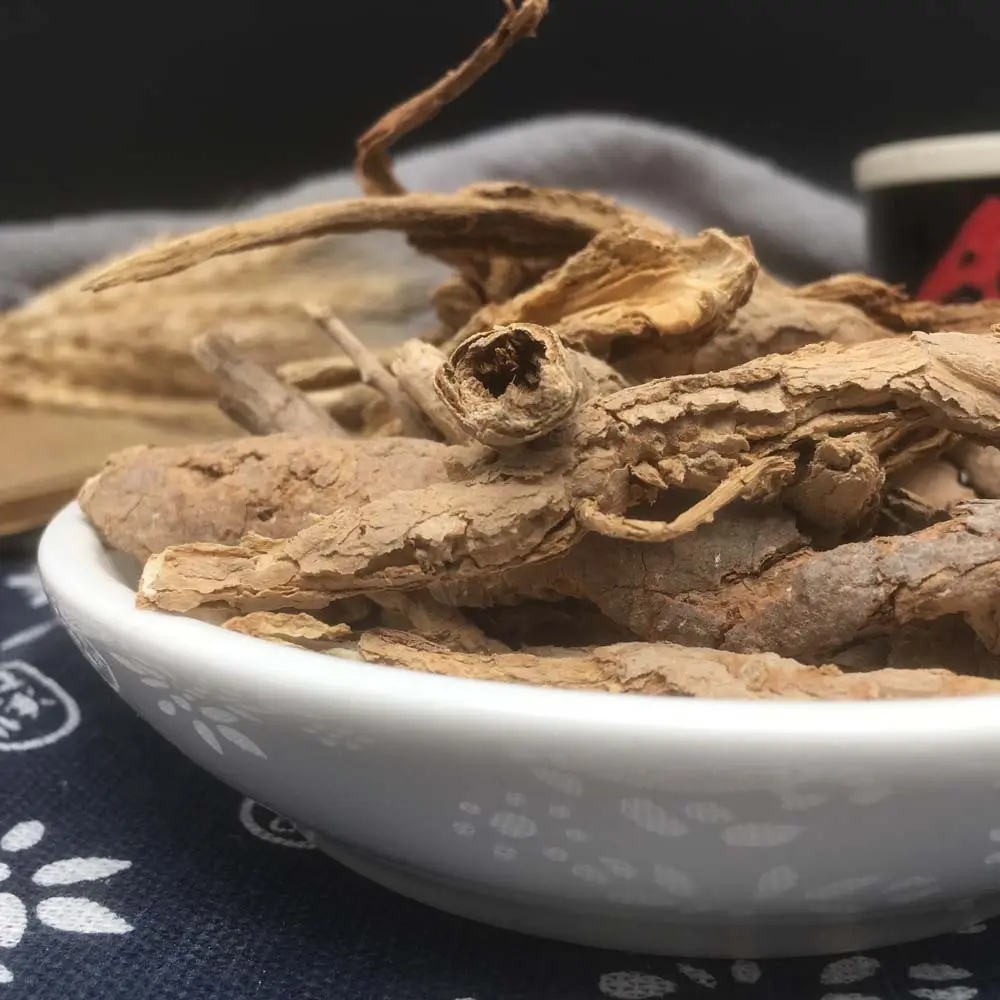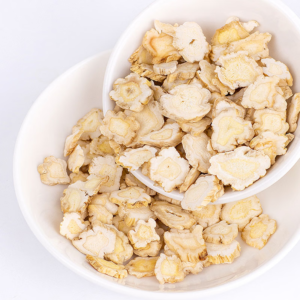Di Gu Pi, [di gu pi] Rehmannia root bark
[Medicinal use] This product is the root bark of Ningxia wolfberry and wolfberry, which belong to the Solanaceae family.
[Nature and flavor and meridians] Sweet, light, cold. Enters the lung and kidney meridians.
[Effects] Clears heat and cools blood, and relieves deficiency heat.
[Clinical application] 1. Used for lung heat cough, asthma, or blood in sputum.
When pathogenic heat attacks the lungs, the lungs fail to descend, and then they go up and cause asthma and cough; when heat injures the lung collaterals, blood overflows and is trapped in the sputum, which means there are blood streaks in the sputum. Rehmannia root bark can clear lung heat, and when lung heat is removed, lung qi is cleared, and asthma and cough can be reduced. It is often used together with mulberry bark.
2. Used for blood heat, hematemesis, epistaxis, hematuria and other symptoms.
Rehmannia root bark enters the blood and cools blood, so it can also be used for hematemesis, epistaxis and other symptoms, and can be used with Imperata root, Platycladus orientalis leaves and the like.
3. Used for Yin deficiency fever and other symptoms.
Rehmannia root bark is good at relieving deficiency heat, and is particularly suitable for symptoms such as fever due to yin deficiency and persistent low-grade fever. It is often used with Artemisia annua, turtle shell, and white mulberry.
[Prescription name] Rehmannia root bark (wash, dry, and chop)
[General dosage and usage] Three to five coins, decocted and taken.
[Comments] 1. Both Rehmannia root bark and Cortex Moutan can cool blood and treat deficiency heat, and are used for fever due to yin deficiency. However, Rehmannia root bark can clear lung heat; while Cortex Moutan can clear liver heat, clear blood heat, and activate blood circulation and disperse blood stasis. This is the main difference between the two medicines.
2. Regarding the treatment of fever due to yin deficiency, the predecessors said that “Cortex Moutan treats bone steaming without sweating, and Rehmannia root bark treats bone steaming with sweating”, but there is no such strict distinction in clinical practice now, and when used for fever due to yin deficiency, both medicines can be used together regardless of sweating or not.
3. The root of wolfberry is called wolfberry root, and its function is similar to Rehmannia root bark (root bark of wolfberry). Lycium barbarum root is available in herbal medicine stores in Shanghai. It is often used for tuberculosis hot flashes, persistent low-grade fever, and hypertension. The general dosage is 5 qian to 1 liang, decocted and taken orally.
[Example of prescription] Di Gu Pi Tang “Shengji Zonglu”: Di Gu Pi, Bie Jia, Zhi Mu, Chai Hu, Qin Jiao, Fritillaria, Angelica. Treats asthenia and bone steaming hot flashes.
Xie Fei San (formerly Xie Bai San) “Xiao Er Yao Zheng Zhi Jue”: Di Gu Pi, Morus alba, Japonica rice, Licorice. Treats lung fire stagnation, shortness of breath, cough, irritability and red tongue.
This product is the dried root bark of Lycium chinense Mi. or Ningxia Lycium barbarum L. of the Solanaceae family. Dig up the roots in early spring or late autumn, wash, peel off the root bark, and dry in the sun.
[Propiedades]
This product is cylindrical or grooved, 3~10cm long, 0.5~1.5cm wide, 0.1~0.3cm thick, with grayish yellow to brownish yellow outer surface, rough, with irregular longitudinal cracks, and easy to flake off. The inner surface is yellowish white to grayish yellow, relatively flat, with fine longitudinal lines. It is light, brittle, easy to break, and has an uneven cross section. The outer layer is yellow-brown and the inner layer is grayish white. It has a faint smell and tastes slightly sweet and then bitter.
[Identificación]
(1) Cross section of this product: The cork layer is composed of more than 4~10 rows of cells, with a thicker fallen bark layer outside. The phloem rays are mostly 1 row wide: the fibers are scattered individually or in bundles of 2 to several. The thin-walled cells contain calcium oxalate sand crystals and many starch granules.
(2) Take 1.5g of the powder of this product, add 15ml of methanol, ultrasonically treat for 30 minutes, filter, evaporate the filtrate, and add 1ml of methanol to the residue to dissolve it as the test solution. Take another 1.5g of Radix Rehmanniae as a control medicinal material and prepare the control medicinal material solution in the same way. According to the thin layer chromatography method (General Rule 0502), take 51 of each of the above two solutions and spot them on the same silica gel G thin layer plate, use toluene-acetone-formic acid (10:1:0.1) as the developing agent, develop, take out, dry, and examine under ultraviolet light (365nm). In the chromatogram of the test product, at the corresponding position of the chromatogram of the control medicinal material, a fluorescent spot of the same color appears.
【Inspección】
The water content shall not exceed 11.0% (General Rule 0832 Method 2).
Total ash content shall not exceed 11.0% (General Rule 2302)
Acid insoluble ash content shall not exceed 3.0% (General Rule 2302)
Piezas de decocción
[Tratamiento]
Remove impurities and residual wood core, wash, and dry in the sun or at low temperature.
[Propiedades]
This product is cylindrical or trough-shaped, of varying lengths. The outer surface is grayish yellow to brownish yellow, rough, with irregular longitudinal cracks, and easy to flake off. The inner surface is yellowish white to grayish yellow, relatively flat, with fine longitudinal lines. The body is light, brittle, easy to break, and the cross section is uneven, the outer layer is yellow-brown, and the inner layer is grayish white. The smell is slight, and the taste is slightly sweet and then bitter.
[Identificación][Inspección]
Lo mismo que los materiales medicinales.
[Naturaleza y sabor y meridianos]
Sweet, cold. Enter the lung, liver, and kidney meridians.
[Funciones e indicaciones]
Cool blood and eliminate steaming, clear the lungs and reduce fire. Used for yin deficiency hot flashes, bone steaming and night sweats, lung heat cough, blood, blood, internal heat and thirst.
【Uso y dosificación】
9~159.
【Almacenamiento】
Place in a dry place.
Where is the main production area of Dry Bone Bark?
It is produced in most parts of the country.
Where is the main medicinal part of the Dry Bone Bark?
Medicinal Parts of Dry Bone Bark:
The Chinese medicinal material Dry Bone Bark is the dried root bark of Lycium chinense Mi. or Lycium barbarumL. of the Solanaceae family. The roots are dug in early spring or late autumn, washed, peeled, and dried.
Characteristics of the medicinal part of Dry Bone Bark:
This product is cylindrical or groove-shaped, 3~10cm long, 0.5~1.5cm wide, and 0.1-0.3cm thick. The outer surface is grayish yellow to brownish yellow, rough, with irregular longitudinal cracks, and easy to flake off.
The inner surface is yellowish white to grayish yellow, relatively flat, with fine longitudinal lines. It is light, brittle, easy to break, and the cross section is uneven. The outer layer is yellow-brown and the inner layer is grayish white. The smell is slight, the taste is slightly sweet and then bitter.
How are the root bark of Rehmannia recorded in ancient books?
“Ben Jing”: “It is used to treat evil qi in the five internal organs, thirst in the heat, and arthralgia.
“Zhenzhu Nang”: “It can relieve bone steaming, muscle heat, thirst, rheumatism, strengthen tendons and bones, and cool blood.
“Tangye Bencao”: “It can relieve kidney fire, reduce the latent fire in the lungs, remove the fire in the cells, reduce fever, and replenish the positive energy.
“Ben Cao Qiu Zhen”: “Although it is the same agent for treating bone steaming as Danpi, Danpi tastes pungent and can treat bone steaming without sweating, while this one is sweet and can treat bone steaming with sweating.
Efectos
Rehmannia has the effects of cooling blood and removing steaming, clearing the lungs and reducing fire.
What are the main effects and clinical applications of Rehmannia?
Rehmannia is used for yin deficiency hot flashes, bone steaming and night sweats, lung heat cough, hemoptysis, blood, and internal heat and thirst.
Yin deficiency fever
Treats internal heat due to yin deficiency, bone steaming and night sweats. It can be used alone or with Anemarrhena asphodeloides, Biejia, and Bupleurum chinense.
Tos por calor pulmonar
Often used with Morus alba and Licorice.
Blood heat bleeding
Treats hematemesis, epistaxis, hemoptysis and other bleeding caused by blood heat. It can be used with Cirsium japonicum, Agrimoniae, and Platycladus orientalis.
What other effects does Rehmannia glutinosa have?
The commonly used medicinal diet recipes for Rehmannia glutinosa are as follows:
Rehmannia glutinosa porridge
·Rehmannia glutinosa 15g, 100g polished rice, and appropriate amount of rock sugar.
. Wash the Rehmannia glutinosa, decoct it in water to remove the residue and take the juice, add polished rice to cook porridge, add rock sugar when it is cooked, and boil it for a few more times. 1 dose per day for 3 to 5 consecutive days.
Rehmannia glutinosa drink
·Rehmannia glutinosa 15g, Ophiopogon japonicus 6g, and wheat 6g.
·Wash the Rehmannia glutinosa, Ophiopogon japonicus and wheat separately. Put the above three ingredients into the pot together and add appropriate amount of water. Bring to a boil over high heat, then continue to simmer over low heat; until the wheat is cooked, remove the residue and take the juice. Drink it instead of tea.
Nota: El uso de materiales medicinales chinos debe basarse en la diferenciación y el tratamiento de los síndromes y debe realizarse bajo la guía de profesionales de la medicina china. No los use a voluntad ni escuche las prescripciones y anuncios de la medicina china.
What are the compound preparations containing Rehmannia root bark?
Qinggu San clears heat from the void and relieves bone steaming. It is mainly used to treat liver and kidney yin deficiency and internal disturbance of virtual fire. Bone steaming hot flashes, or low fever that does not subside for a long time, the body disappears phlegm, the lips are red, sleepy and sweating, or thirsty and upset, the tongue is red and has little coating, and the pulse is thin and rapid.
Xiebai San
Clears and drains lung heat, relieves cough and asthma. It is mainly used to treat lung heat asthma and cough. Asthma and cough, steaming and hot skin, especially during feeding, red tongue with yellow coating, and thin and rapid pulse.
Modern research progress on Radix Rehmanniae
Modern research shows that the Chinese medicinal material Radix Rehmanniae has multiple pharmacological effects such as anti-pathogenic microorganisms, antipyretic, hypoglycemic, and hypolipidemic.
Uso
Radix Rehmanniae has the effects of cooling blood and removing steam, clearing lungs and reducing fire. Generally, Radix Rehmanniae slices are used for decoction. Please follow the doctor’s instructions for specific medication.
How to use Radix Rehmanniae correctly?
When Radix Rehmanniae decoction is taken orally, the common dosage is 9~15g.
When used externally, take an appropriate amount of Radix Rehmanniae, decoct water for gargling, rinsing; or grind into powder for sprinkling, mixing and applying; or fresh product for pounding and applying.
Through different processing methods, Chinese medicinal materials such as Radix Rehmanniae and fried Radix Rehmanniae can be produced. Different processing methods have different effects, but the method of use is the same. Please follow the doctor’s instructions for specific medication.
Radix Rehmanniae is generally used in decoctions, decoctions are taken, and can also be made into powders or pills for consumption. However, the use of Chinese herbal medicines must be treated according to syndrome differentiation and should be used under the guidance of professional Chinese medicine practitioners. They should not be used at will, and should not be used at will by Chinese medicine prescriptions and advertisements. Common Chinese medicine combinations are as follows:
Rehmannia root bark with mulberry bark: Rehmannia root bark can clear lung fire and benefit yin; mulberry bark can clear heat, purge lungs and relieve asthma, and also be a diuretic. The combination of the two medicines can clear lung fire, promote diuresis and guide heat evil out of the urine, and moisten the lungs without bitterness and damage to yin, so it is used to treat lung heat cough. In addition, Rehmannia root bark can also be soaked in wine. It can be soaked in wine with Chinese medicines such as Citrus aurantium, Angelica dahurica, and Acanthopanax cortex, which has the effect of nourishing the liver and kidneys and dispelling wind and cold.
How to prepare Rehmannia root bark?
Remove impurities and residual wood core, wash and dry.
What drugs should be used with Rehmannia root bark at the same time with special attention?
The combined use of Chinese and Western medicines requires syndrome differentiation and treatment and clinical individualized treatment.
If you are taking other medications, please consult a doctor before taking the medicine, and inform the doctor of all your confirmed diseases and treatment plans.
Instrucciones de medicación
Dry bone bark is sweet, cold and refreshing, so it is not suitable for people with spleen deficiency and loose stools and those with unresolved external evil.
What precautions should be taken when using the dry bone bark?
· It is not suitable for people with exogenous wind-cold fever or spleen deficiency and loose stools.
· This product has a faint smell and tastes slightly sweet and then bitter. Large pieces, thick meat, no wood core, and yellow color are preferred. Use raw.
During the medication period, be careful not to eat cold, raw and cold foods, spicy and greasy foods, and avoid smoking and drinking. .
Pregnant and breastfeeding women: If you are pregnant, planning to become pregnant, or are breastfeeding, please inform your doctor in time and consult whether Chinese medicine can be used for treatment.
· Niños: La medicación en niños debe realizarse bajo guía médica y supervisión de un adulto.
· Guarde adecuadamente los materiales medicinales y no entregue sus propios materiales medicinales a otras personas.
· Avoid using copper or iron utensils to decoct medicine.
How to identify and use Radix Rehmanniae?
Radix Rehmanniae and Paeoniae Suffruticosa
Both are heat-clearing drugs, which can reduce deficiency heat and cool blood, treat yin deficiency fever, bone steaming hot flashes, blood heat vomiting and bleeding, premenstrual fever, and premature menstruation. However, Paeoniae Suffruticosa is the dried root bark of Paeonia sufruticosa Andr., a plant of the Ranunculaceae family. The medicinal properties are bitter and slightly cold, and are more dispersing and dry. Although it does not restrain evil, it is suspected of hurting yin, so it is good at treating yin injury without sweating and bone steaming; it specifically enters the blood, can activate blood circulation and remove blood stasis, and has the advantages of cooling blood without leaving blood stasis, activating blood circulation without moving blood, and is good at clearing liver fire, and is also good at treating blood heat macules, blood stasis amenorrhea, dysmenorrhea, irregular menstruation, scars, bruises and swelling, intestinal abscesses and abdominal pain. Liver depression and fire chest pain and liver heat red and swollen eyes, etc.
Rehmannia root bark is the dried root bark of Lycium chinense Mi. or Lycium barbarum L. of the Solanaceae family. It is sweet and cold in nature, and can relieve deficiency heat and nourish the body. Although it does not hurt the yin, it is suspected of restraining evil, so it is good at treating severe yin injury such as sweat and bone steaming. It also enters the qi and is good at clearing the lungs and reducing fire, treating lung heat cough; nourishing yin and promoting fluid production, treating internal heat and thirst; relieving kidney meridian deficiency fire, treating deficiency fire toothache.
Consejos sobre medicación
Preguntas más frecuentes de los pacientes
Rehmannia root bark porridge recipe and efficacy
[Raw materials] Rehmannia root bark 30g, mulberry bark 15g, Ophiopogon japonicus 15g, polished rice 100g.
[Method] First decoct the above three herbs, remove the residue and take the juice for later use, wash the polished rice, put it into the pot and add the boiled medicinal juice, boil it with high heat, then turn to low heat and continue to cook into porridge.
[Effects] Clear the lungs, promote fluid production, and quench thirst. Treats thirst (diabetes), polydipsia, and weight loss.
[Usage] Take it when thirsty.
Rehmannia root bark drink and its efficacy
[Composition] 15g Rehmannia root bark, 6g Ophiopogon japonicus, and 6g wheat.
[Preparation and Usage] Add water to the above three flavors and boil until the wheat is cooked, remove the residue and take the juice, and drink it frequently instead of tea.
[Effects] Nourishing yin, clearing heat, and stopping sweating.
[Main Indications and Applications] Yin deficiency and internal heat syndrome. Suitable for yin deficiency and internal heat, dizziness, tinnitus and deafness, five-heart heat, irritability, bone steaming and hot flashes, night sweats, thirst, dry tongue and sore throat, etc. Diabetes, hyperthyroidism, hypertension, chronic bronchitis, tuberculosis, malnutrition fever in children, lung heat cough and hemoptysis, and perimenopausal syndrome are yin deficiency and internal heat syndromes, and this prescription can be added or subtracted.
[Precautions for use] This diet nourishes yin and clears heat, and is suitable for symptoms caused by yin deficiency and internal heat. It should be used with caution in patients with exogenous fever.
Di gu pi – Lycii Cortex
Rango de precios: desde $58.88 hasta $32,666.00
+ Envío GratisDi Gu Pi, [di gu pi], Chinese herbal medicine, alias: Qi root, Di Gu, Lycium barbarum root, Lycium barbarum root bark, Red Pomegranate root bark, English name: Lycii Cortex, main effects: cooling blood and removing steaming, clearing lungs and reducing fire
The Chinese herbal medicine Di Gu Pi is a heat-clearing medicine, which is the dried root bark of Lycium barbarum or Ningxia Lycium barbarum of the Solanaceae family.
The Chinese herbal medicine Di Gu Pi is sweet and cold in nature, and it enters the lung, liver, and kidney meridians.
Di Gu Pi is sweet and cold, clearing and moistening, and enters the lung, liver, and kidney meridians. It enters both the blood and the qi, clearing and descending without penetrating, and slightly moisturizing. It is good at relieving deficiency heat (removing steaming), cooling blood heat, purging lung fire, and generating body fluid without penetrating. It is suitable for all deficiency heat, blood heat, lung fire, and body fluid damage. It is best for treating sweat and bone steaming, and can be used to treat blood heat and bleeding. It is commonly used to treat lung heat cough.
This product mainly contains alkaloids: betaine, scopolamine A, scopolamine, lycium barbarum amide, atropine, etc.; it also contains organic acids, phenols and sterols, etc. It has the effects of cooling blood, removing steam, clearing lungs and reducing fire.
| Peso | 1kg, 10kg, 100kg, 500kg, 1000kg |
|---|






















Reseñas
Aún no hay reseñas.